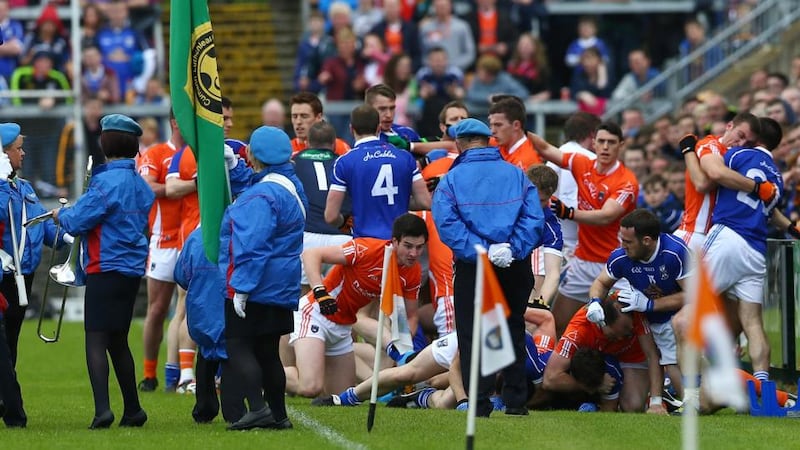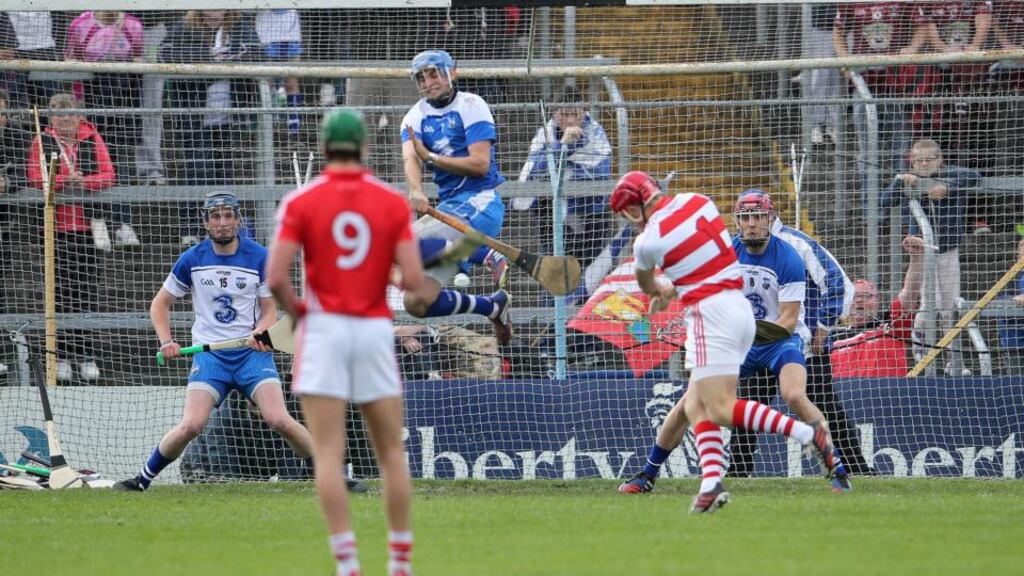The murmurs that went around Tuam Stadium on Sunday afternoon, where I was watching a club game, will be familiar to many. The stadium announcer had already told us of Mayo’s narrow escape from Hyde Park, but the stand was abuzz with word that there had been a big row in the Cavan/Armagh game . . . during the parade.
And so we tuned into the Sunday Game, outrage button at the ready. As is so often the case, the players in question came off looking ridiculous. Telling them they are a stain on this great Association they represent doesn’t appear to have much of an impact, so maybe informing them that they looked like a bunch of drunks trying to help each other put on their jackets at the end of a long night might shame them into improved behaviour.
They just looked like idiots. It was all a little unseemly and grim-looking, until Armagh’s Ciarán McKeever tried to sneak back up to the top of the queue after two minutes of fighting had finally abated, and we then finally crossed the line into high farce. The spectre of violence hangs over many moments in the course of a GAA game, but I wouldn’t have thought the pre-match parade was one of them.

But Oisín McConville told us on The Irish Times Second Captains podcast on Monday that there were occasions during Joe Kernan’s reign that Armagh would insist on marching on the side closer to the crowd – I would have chalked this down as a Northern peccadillo (and Oisín’s already made all the ‘flag/marching/traditional parade route’ gags there are to make) but Ciarán Whelan had also said something similar on the Sunday Game.
I didn’t know that there was a preferred racing line for players in a pre-match parade – if you’re on the inside (so the logic goes), you’re further away from the crowd, plus you have to slow down as you turn the corner . . . and you obviously don’t want to do that.
It’s a minefield, what with players inevitably cramping up at the rapid deceleration on that inside line, or worse still, treading on team-mates’ Achilles tendons, endangering the careers of your brothers in arms.
Given the energy with which Cavan and Armagh players went about their quest to parade on the side closest the crowd in the Athletic Grounds in Armagh on Sunday, this is a major psychological battlefield that we weren’t even aware existed.
Many people were expressing relief that the Sky cameras weren’t there to capture these shameful scenes, as if this was the dirty secret we were trying to hide from our new housemate for as long as possible. But sure enough the footage turned up on Sky Sports News on Monday, and let’s be honest – human nature being what it is, Gaelic games probably didn’t lose any prospective new fans over it, and might even have gained a few.
The real bravery that Sky might have done well to highlight was shown on Sunday afternoon, when Stephen O'Keeffe ran headlong from his goal to close down the space between him and a penalty struck by Anthony Nash, with all the brute force that we've come to expect from the Corkman. It paid off handsomely, as O'Keeffe stopped the shot with his leg, but we now need to save hurling goalkeepers from themselves.
With the GAA confirming on Sunday night to RTÉ that the rule-book deems the penalty to have been taken once the taker jab-lifts the ball up into the air, the Nash style of penalty is now daring hurling goalkeepers to get within a couple of yards of a ball being struck at 90-plus miles per hour, as O’Keeffe did . . . and a failure to do so could be deemed cowardice!
GAA president Liam O’Neill suggested on Monday morning that they couldn’t mess about with rules in the middle of a season, but that attitude appeared to be softening in the GAA even as the day progressed – in fact, now it looks like action could be taken in time for next weekend’s games.
There was obviously a realisation that there is no point waiting for a potentially catastrophic injury to be suffered before taking action on this. O’Keeffe’s bravery should be respected, but the precedent it sets is asking for trouble.
There is a difference between walking around grabbing people’s jerseys and daring them to punch you in the face, as is usually the norm in mass GAA outbreaks of machismo, and doing the equivalent of running up to a baseball pitcher’s mound and asking him to throw his fast ball at your chest from a couple of feet away. It appears the GAA will be forever cursed with the faux bravery . . . they have an opportunity to do away with the other option, where bravery crosses over into real peril, and they must take that opportunity.










